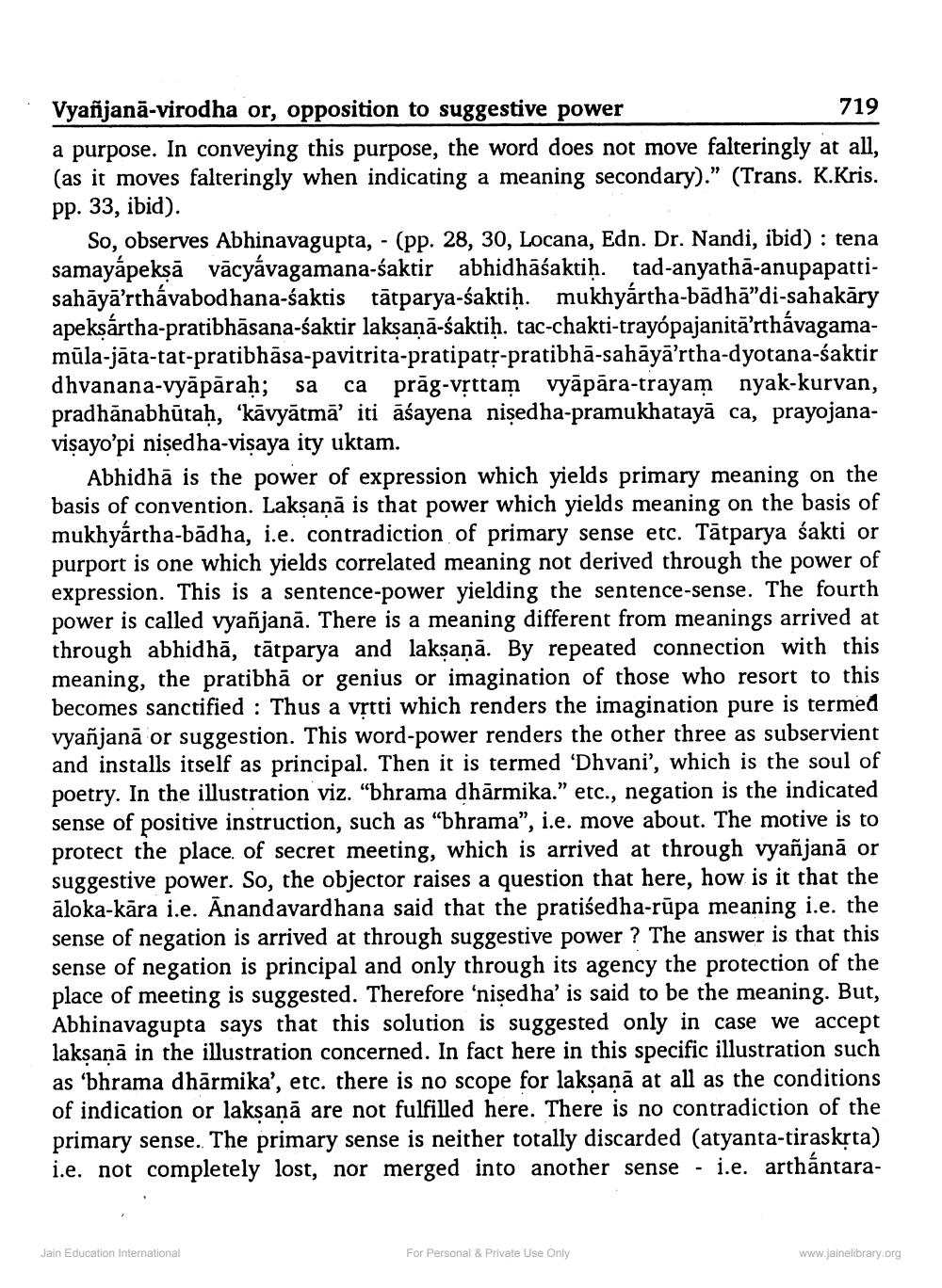________________
Vyañjanā-virodha or, opposition to suggestive power
719 a purpose. In conveying this purpose, the word does not move falteringly at all, (as it moves falteringly when indicating a meaning secondary).” (Trans. K.Kris. pp. 33, ibid).
So, observes Abhinavagupta, - (pp. 28, 30, Locana, Edn. Dr. Nandi, ibid) : tena samayápeksā vācyávagamana-saktir abhidhāśaktih. tad-anyathā-anupap sahāyā’rthávabodhana-śaktis tātparya-saktiḥ. mukhyártha-bādhā"di-sahakāry apeksártha-pratibhāsana-śaktir laksanā-saktiḥ. tac-chakti-trayópajanitā’rthávagamamūla-jāta-tat-pratibhāsa-pavitrita-pratipatr-pratibhā-sahāyā’rtha-dyotana-śaktir dhvanana-vyāpārah; sa ca prāg-vșttam vyāpāra-trayam nyak-kurvan, pradhānabhūtaḥ, kāvyātmā’iti āśayena niședha-pramukhatayā ca, prayojanavisayo’pi niședha-visaya ity uktam.
Abhidhā is the power of expression which yields primary meaning on the basis of convention. Laksaņā is that power which yields meaning on the basis of
adha. i.e. contradiction of primary sense etc. Tātparya sakti or purport is one which yields correlated meaning not derived through the power of expression. This is a sentence-power yielding the sentence-sense. The fourth power is called vyañjanā. There is a meaning different from meanings arrived at through abhidhā, tātparya and laksaņā. By repeated connection with this meaning, the pratibhā or genius or imagination of those who resort to this becomes sanctified: Thus a vrtti which renders the imagination pure is termed vyañjanā or suggestion. This word-power renders the other three as subservient and installs itself as principal. Then it is termed 'Dhvani', which is the soul of poetry. In the illustration viz. “bhrama dhārmika." etc., negation is the indicated sense of positive instruction, such as “bhrama", i.e. move about. The motive is to protect the place, of secret meeting, which is arrived at through vyañjanā or suggestive power. So, the objector raises a question that here, how is it that the aloka-kāra i.e. Ānandavardhana said that the pratiśedha-rūpa meaning i.e. the sense of negation is arrived at through suggestive power? The answer is that this sense of negation is principal and only through its agency the protection of the place of meeting is suggested. Therefore 'nised ha' is said to be the meaning. But, Abhinavagupta says that this solution is suggested only in case we accept laksana in the illustration concerned. In fact here in this specific illustration such as 'bhrama dhārmika', etc. there is no scope for laksanā at all as the conditions of indication or laksaņā are not fulfilled here. There is no contradiction of the primary sense. The primary sense is neither totally discarded (atyanta-tiraskṛta) i.e. not completely lost, nor merged into another sense - i.e. arthántara
Jain Education International
For Personal & Private Use Only
www.jainelibrary.org




